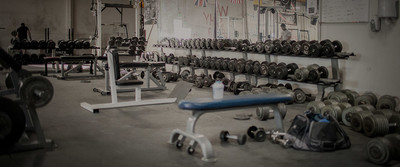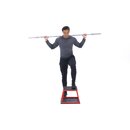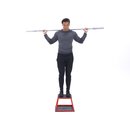Leg training. Ugh! Not everyone loves it, but the results are always worth the pain. The beauty of leg training is that it gives the body a fuller look and puts you far beyond the competition on the amateur level.
For argument's sake, let's pretend that you love leg training. The feeling of not being able to walk for a minute or two after a set of squats makes you want to push yourself into the ground with more intensity.
Now there is just one problem: Your knees feel like they are shot to shit. You've tried to squat... out of the question. You've tried to leg press... lowering the carriage is about to send you wailing like a banshee. The competition is 12 weeks away and you've already committed to it. What now?
Time to reinvent your workout to get your legs shredded and full for the show.
What Doctors Say
When I first hurt my knees, I went to the doctor. In all honesty, I just wanted to hear that I didn't have any tears in my tendons and ligaments, and I would take it from there.
Thankfully, I just had a slight buildup of calcium just above my knee caps. I found it interesting that my doctor told me it was okay for me to squat and leg press. He explained that leg extensions were totally out of the question and bad for my knees. I begged to differ with him.
The knee is the most complex joint in the body. As complex as the knee is, it's an amazing stabilizing joint in certain exercises, even after injury. As a former Division 1-A track athlete, I learned more about how to train legs than anything else. So the workout I'm going to propose to you will not only give you the edge in the competition, it will also show you the brilliance of the human body and its ability to overcome a physical setback.
I do want to stress that you should speak with your doctor before trying this—or any other—exercise regimen.
The Warm-Up
Of course I'm not going to put any running exercises or speed drills in this article. We are bodybuilders, not malnourished rabbits trying to outrun everyone. I've combined my knowledge of muscle development with that of pushing through pain as an athlete to give you an understanding of what we want to accomplish: beautifully shredded legs!
So let's hit it!
Warm-up Exercise Leg Extensions
2 warm-up sets of 40 reps, 4 sets of 30 reps
The leg extension has been given a bad rap by doctors who say it destroys the knees. This exercise alone saved me from having diminutive legs on stage for my first show. If you use this exercise wisely and follow the prescription of what most of the pros do, it will be the staple of your leg workout.
This exercise warms up your quads and get what little blood you have in your joint flowing, with the intent on working the legs to their full potential. Now I will stress you must be careful not to go heavy in the beginning. When bringing the weight up, make sure to lock out your knees with controlled descent.
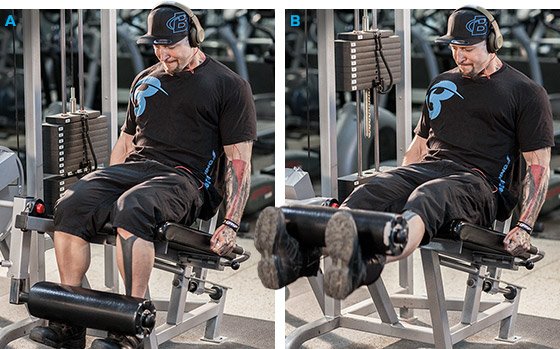
Leg Extensions
You will use this exercise to warm up initially, then move more into quad/ham/glute development from there.
Here is a sample of what you will be doing.
- Leg Extensions: 2 warm-up sets of 40 reps
- Leg Extensions: 4 sets of 30 reps, 60-90 seconds rest
High reps really prepare your quads for the leg workout to follow. You'll have so much blood flowing through your legs you'll be ready to tackle the big exercises, accelerating your leg development. It will be well worth it in the end.
After you have finished leg extensions, your knees should be cooperating fully, with blood, adrenaline, and excitement flowing through them. Okay, so the easy part is done. Now let's get to the real workout.
Stabilization Is The Key!
As I said earlier, the knee is a marvelous joint in stabilization, and for some people you'll be able to get more done on one knee at a time than two knees at the same time.
If you are having knee problems, the best thing you can do is choose exercises that require you to be on one leg at a time. I know what you're thinking: "But doesn't that put more pressure on the joint than using both knees?" I use to think that too, until I realized the human body is meant to be symmetrical in both appearance and strength.
Being on one leg allows people to put their bodies in a better technical position to perform a movement properly without further injuring themselves.
Another reason these particular exercises were chosen is because of the dynamic function of all the muscles involved. All of these exercises will hit the quads, hams and glutes in a maximum effort, so be prepared to be uncomfortable when you sit down.
Many beginning and amateur bodybuilders need to develop a lactic-acid pain threshold. This workout is not for the weak, but if your knees are giving you problems then this workout is for you. Even if you just want to do something different, this workout will be more of a challenge than you think for you healthy people also.
Squatting, leg presses, and hack squats were out of the question for me. So here is where I pulled out some of the old track weight-training that helped me win three first-place trophies in my first show. This workout is only to be done once a week.
Exercise 1 Dumbbell Step ups
4 sets of 15 reps
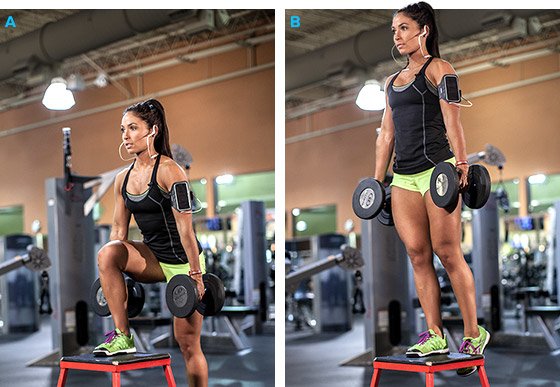
Dumbbell Step-ups
The first exercise is step-ups. You take the bar (or dumbbells), put it on your shoulders in the high bar position, and step up on a bench with one leg. Bring the other leg all the way up into a 90-degree angle, stepping back down to the floor with the 90-degree-angle leg, switching legs the next time you step up.
Exercise 2 Single-Leg Barbell Squat
2-3 sets of 15 reps
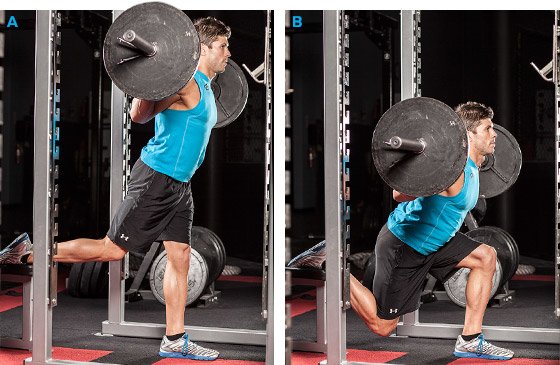
single-leg barbell squat
The next exercise is the single-leg squat. To execute this movement properly you will do the version that requires you to put one leg back, and rest your foot on a bench behind you, so your forward leg comes down in a perfect 90-degree angle.
I prefer using the barbell on these, but using dumbbells is fine also. Perform this exercise by lifting one knee high in the air and stepping out as far as you can, to insure a 90-degree angle on descent. Some people prefer to use the quicker, shorter version by taking smaller steps.
If you have knee problems, I strongly recommend stepping out as far as you can. By the time you get to this exercise your legs are going to be wobbly, so 2 sets will be sufficient to finish off your leg routine.
The separation you will create in your glutes and hams will be phenomenal.
Exercise 3 Barbell Lunges
2-3 sets of 15 reps

Barbell Lunges
The lunge is another great leg-development exercise that can be done after a knee injury, and it is my personal favorite. After leg extensions, step-ups, and single-leg squats, you'd think you'd be done. Oh please! We are trying to win a competition! We need some tears, and you might have been crying at the single-leg squat so this exercise will put an exclamation point on the workout!
I prefer using the barbell on these, but using dumbbells is fine also. Perform this exercise by lifting one knee high in the air and stepping out as far as you can to insure a 90-degree angle on descent. Some people prefer to use the quicker, shorter version by taking smaller steps.
Just as with the single-leg barbell squat, I recommend stepping out as far as you're able to. Your legs may be feeling wobbly by this point, so you only need to do 2 sets.
Exercise 4 Stiff-Legged Barbell Deadlift
4 sets of 8-12 reps
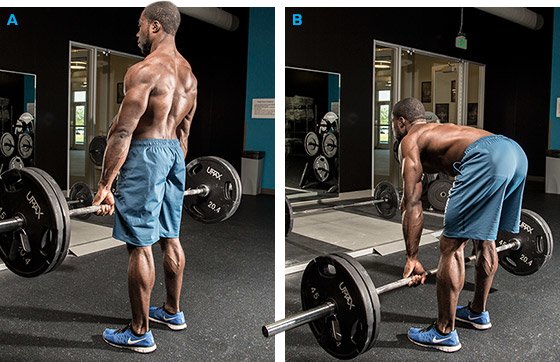
Stiff-legged barbell deadlift
I prefer direct hamstring work, and I feel implementing the lower back is crucial in getting the separation bodybuilders need to have total symmetry. The best exercise for the hams is the stiff-legged deadlift.
A major point I must make here is the need to go heavy in this exercise. I mean heavy! If you are a guy and you weigh at least 170 pounds, you should be able to straight-leg dead 285 pounds. I'm not playing! When this exercise is done right, your hams will pop out like rows of corn.
Plus the benefit of lower-back development and showing striated glutes when you hit a side-chest shot, side triceps, rear-back double biceps, and rear-back lat spread will be insane!
Start with your feet about an inch apart, toes facing forward. The barbell should be resting in front of you on the floor. Grab the barbell with one hand as an underhand grip and the other hand as an overhand grip. Keep your back straight with a slight bend in your knees, and pull the bar with your hams, glutes, and lower back. Hold at the top of the movement for a second, and descend the weight down in full control.

BodyFit
$6.99/month- 2,500+ expert-created single workouts
- 3,500+ how-to exercise videos
- Detailed workout instruction
- Step-by-step workout tips
- Training at gym or at home
- Access to Workout Plans
- Access to Bodyfit App
- Store Discounts
Already have a Bodybuilding.com account with BodyFit? Sign In

What comes with BodyFit?

- Instructional Videos
Don't risk doing a workout improperly! Avoid injury and keep your form in check with in-depth instructional videos.

- How-to Images
View our enormous library of workout photos and see exactly how each exercise should be done before you give it a shot.

- Step-by-Step Instructions
Quickly read through our step-by-step directions to ensure you're doing each workout correctly the first time, every time.
Conclusion
Developing great legs is hard enough, but when you have an injury to your knees it feels like it is impossible. Thankfully the human body is built for compensation.
Use this to fulfill your goals in bodybuilding and do not be afraid of training through injury, discomfort, and pain. In the end, the only thing that separates champions from the wannabes is the will to do what your competition will not do. Good luck.


